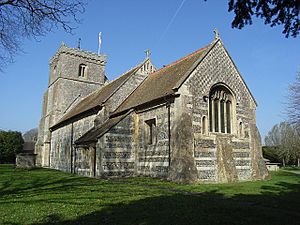Upavon Priory facts for kids
Upavon Priory was a small priory located in Wiltshire, England. A priory is a type of monastery, which is a place where monks or nuns live and dedicate their lives to religious practices. This priory was connected to a larger monastery in France.
The Priory's Beginnings
The story of Upavon Priory starts a long time ago. In 1086, a very important book called the Domesday Book was created. This book was a huge survey of England, listing who owned what land. It showed that land in Upavon was owned by the Benedictine monastery of Saint-Wandrille in Normandy, France.
It's believed that a priory was first built in Upavon during the 12th century. Later, in the 13th century, the church there became a "prebend" of Salisbury Cathedral. This meant it was linked to the cathedral and provided income for one of its clergy members.
Life at the Priory
We don't know a lot about daily life at Upavon Priory, but some old records give us clues. A list from 1324 showed that the priory had some animals, like two horses, and simple furniture, including two beds and three tables. The chapel, where the monks prayed, had only a few basic items. Around this time, a nearby church in Charlton St Peter also became part of the priory's property.
Changes Over Time
The priory faced big changes in the late 1300s. In 1378, monks from "alien priories" were sent out of England. Alien priories were small monasteries that were controlled by larger ones in other countries, like France. After this, Upavon Priory stopped being a religious home and became a farm.
Later, in 1423, Upavon Priory was given to another group of religious people: the Augustinian canons of Ivychurch Priory. Ivychurch Priory was located southeast of Salisbury. The Augustinian canons kept Upavon Priory until a major event called the Dissolution. This was when King Henry VIII closed down many monasteries across England in the 16th century.
The Priory's End
Records show that there were leaders, called "priors," at Upavon Priory between 1262 and 1361. However, after the Dissolution, the priory buildings slowly disappeared. The very last building, a barn located between the church and the River Avon, was taken down in the early 1820s. Today, nothing remains of the original Upavon Priory buildings.


